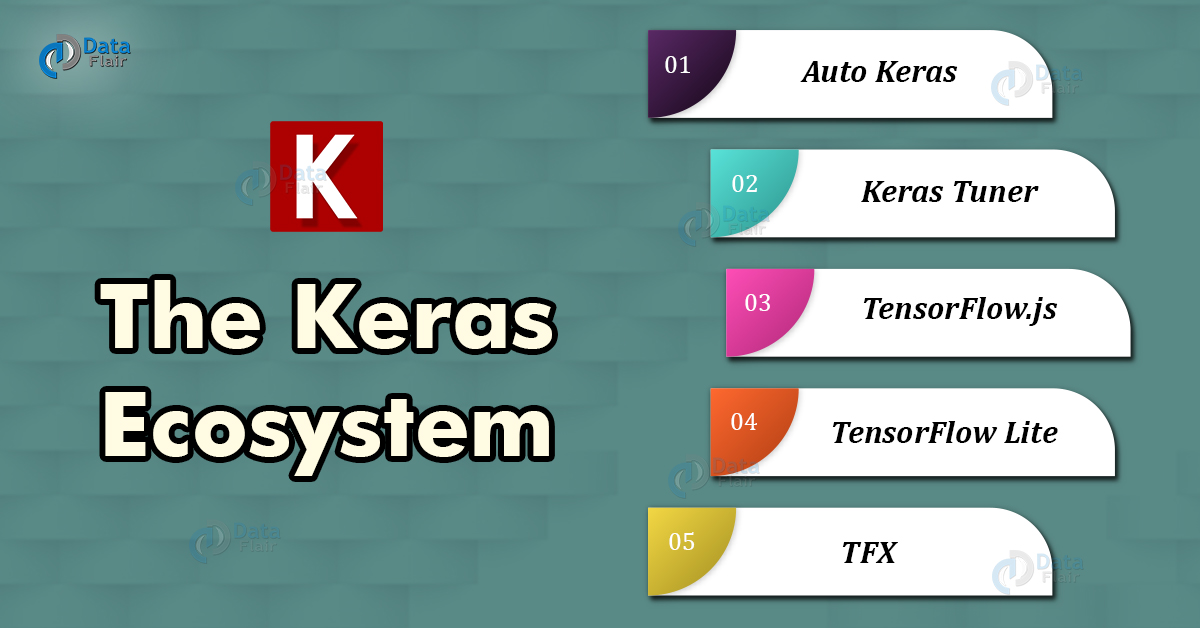Keras Ecosystem – Keras Open Source Frameworks
Free Keras course with real-time projects Start Now!!
Keras, other than being a high-level deep learning API also has some other initiatives for machine learning workflow. There is a wide range of machine learning frameworks whose development is based on Keras. In this article, we will discuss Keras Ecosystem. This ecosystem of frameworks tries to ease and optimize the current approach of training and deploying ML models.

Keras Ecosystem
Some of the frameworks for Keras Ecosystem are:
1. Auto Keras
This framework was built at the DATA lab with an ambition of making machine learning accessible to everyone.
It is a simple interface to perform many machine learning tasks. The supported tasks in auto Keras are image classifier, image regression, text classification, text regression, structured data classification, and structured data regression.
An example of image classification task using auto Keras:
import numpy as np from keras.datasets import mnist import autokeras as ak (x_train,y_train),(x_test,y_test)=mnist.load_data() classifier=ak.ImageClassifier(max_trials=5) classifier.fit(x_train,y_train,epochs=10) prediction=classifier.predict(x_test) classifier.evaluate(x_test,y_test)
2. Keras Tuner
This framework was developed to remove the headache of searching hyperparameters. It is a scalable and easy framework for optimizing hyperparameters. It helps you to find hyperparameters values which are best suitable for your model.
Install the Keras Tuner using:
pip3 install -U keras-tuner
How to use keras Tuner:
We use keras Tuner with the help of hp argument while building the neural network model.
For Example
from keras.layers import Dense
from kerastuner.tuners import RandomSearch
from keras.optimizers import Adam
model = keras.Sequential()
model.add(Dense(units=hp.Int('units',
min_value=32,
max_value=512,
step=32),
activation='relu'))
model.add(Dense(10, activation='softmax'))
model.compile(
optimizer=Adam(
hp.Choice('learning_rate',
values=[1e-2, 1e-3, 1e-4])),
loss='categorical_crossentropy',
metrics=['accuracy'])3. Keras Tensorflow.js
This framework was developed to deploy Keras deep learning models on the browser or node.js servers. You can even train neural network models on browsers or servers. This framework provides a great way of learning for the developers who are familiar with javascript but are new to machine learning.
Features of Tensorflow.js:
- It allows us to import pre-trained or existing Keras or TensorFlow models.
- We can retrain an imported model on the web browser.
- It allows us to use transfer learning to augment the model using image retraining.
4. Tensorflow Lite
This is open-source software that was developed to enable deep learning models on mobile devices. Generally, machine learning models require space and GPU to run, but these resources are not available on mobile.
Tensorflow lite converts the trained Keras or TensorFlow models into a small and optimized version. Tensorflow lite stores the model in the form of .tflite file form.
The devices utilizing TensorFlow lite are generally mobile devices, internet of things devices, and raspberry pi.
Characteristics of Tensorflow Lite:
- Optimization of large TensorFlow or Keras deep learning models.
- It provides an offline interface to mobile devices.
- Tensorflow lite may affect the performance of the model. Generally, TensorFlow lite models have lower accuracy than the actual model.
5. TFX
TFX is a tool to create and manage production pipelines for deploying our deep learning models at the production stage.
Install TFX using:
pip3 install tfx
Using TFX you can:
- Create machine learning workflow on different platforms such as Apache Beam, Apache Airflow, and Kubeflow.
- Use TFX components which helps to build a machine learning process.
In a nutshell, TFX provides a toolkit as a configuration framework to integrate basic components for monitoring your deep learning system.
Some popular TFX components are:
- ExampleGen: for dataset ingestion and spitting.
- StatisticsGen: to calculate statistics on a dataset.
- SchemaGen: to create data schema.
- Transform: to apply feature engineering on the dataset.
Some popular TFX libraries are:
- Tensorflow Data Validation: a python package for data analysis.
- TFX Tensorflow Transform: helps data processing in TensorFlow.
- Tensorflow Metadata: to describe tabular data and provide statistics over the dataset.
6. Model Optimization Toolkit
Tensorflow provides this toolkit to optimize machine learning models for deployment. The major applications of this toolkit are:
- Minimize latency cost for mobile and IoT devices.
- Deployment and maintenance of deep learning models on access devices such as wide area network devices.
This toolkit provides the following features:
- Helps to choose the best model for our needs. It suggests models based on the size and complexity required.
- Checks whether any existing pre-optimized models are available for our application.
- Allows optimization of already- trained Tensorflow models.
Summary
This article guides you to four open-source frameworks that are part of the Keras ecosystem. These four frameworks are Auto Keras, Keras Tuner, Tensorflow.js. Tensorflow Lite. All this framework works at a high level with their base on either Keras or Tensorflow. Auto Keras eases Keras operations, Keras tuner helps to decide hyperparameters. Tensorflow.js deploys the model in the browser and Tensorflow life is for making ML models accessible to mobile devices.
Your 15 seconds will encourage us to work even harder
Please share your happy experience on Google

